October 15, 2019
A Mixture of Air Compressor Technologies Creates a Smart, Reliable System
SHARE THIS POST
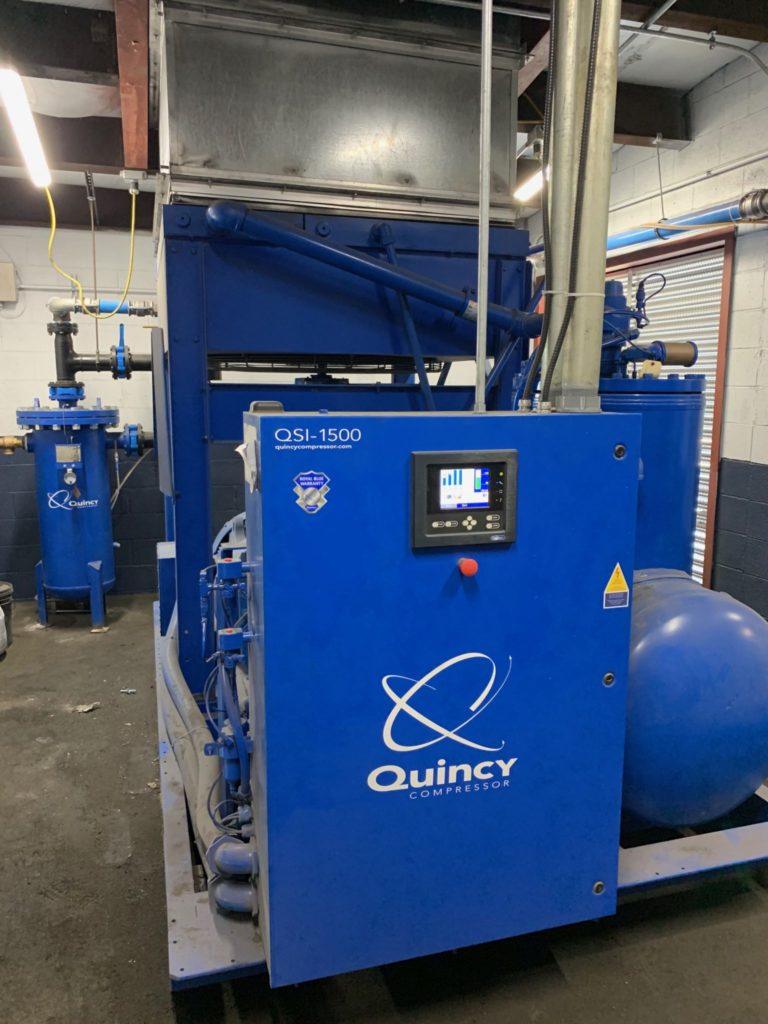
The new Quincy QSI 1500 Air Compressor.
A mixture of air compressor technologies creates a smart, reliable system for a local foundry. This customer recently purchased a Quincy QSI-1500 air compressor to replace two 150 HP compressors that were old and worn out. The facility still has two 200 HP air compressors from two different manufacturers, and an older Quincy QSI-1000. The customer expressed interest in networking all these machines together but wasn’t sure how it would work with the mixture of brands and the fact that the machines are split between two separate compressor rooms. The C.H. Reed Controls Group was able to deliver using advanced air compressor technologies; here’s how.
Compressed Air System Networking
The four different air compressors were split between two rooms in the plant. The first 200 HP compressor (we’ll call compressor A) shared a room with the new Quincy QSI-1500, and the second 200 HP unit (we’ll call compressor B) shared a room with the older Quincy QSI-1000.
From a networking standpoint, we had a couple different options: To try and connect the two rooms would require a very long cable run inside the plant with multiple signal repeaters along the way. This was not a viable option. Another method would involve using a pair of CAN-Ethernet gateways to utilize the existing ethernet network of the building to connect the rooms. The distance from one of the rooms to the nearest network switch was not much less than running a cable between the rooms. This was not a good option either. While the distance between the rooms was very far from inside the plant, on the outside they were separated by a small courtyard about 100 feet wide. It was decided that we would use our Magnetek Enrange WIC-2400 Wireless CAN Modules to connect the two compressor rooms. The WIC-2400 has a range of up to 1500 feet and has performed flawlessly in the past. We were confident this was the solution.
Since the distances were rather short, and it was more economical than going 100% wireless, the compressors that shared rooms were hardwired to one another. Compressor A was hardwired to the new QSI-1500, and the new QSI-1500 was hardwired to one of the WIC-2400’s. In the other room, Compressor B was hardwired to the old QSI-1000, and the old QSI-1000 was hardwired to the other WIC-2400. The antennae for the WIC-2400’s were stubbed through the exterior walls and communication between the rooms was established. (For more information about the Magnetek Enrange WIC-2400 Wireless CAN Module, click here.)
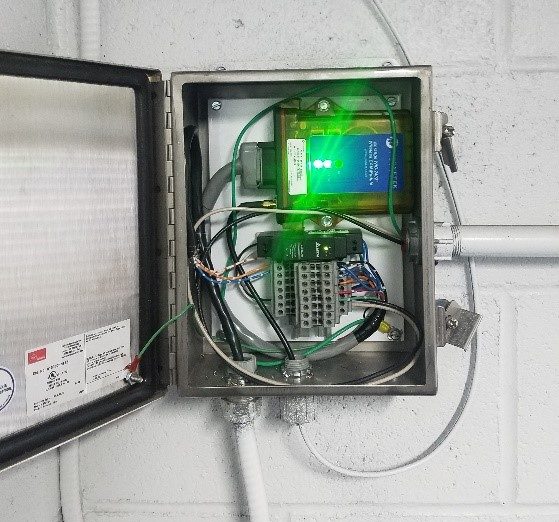
WIC-2400 Wireless CAN Module wall-mounted inside a stainless-steel box.
The other networking challenge to overcome was the mixed control systems the individual air compressors used. The new QSI-1500 has Quincy’s Q-Controller, while Compressor A is an old gauge machine. The QSI-1000 is an older Legacy Power$ync machine, and Compressor B has the Auto Sentry controller. None of these controllers speak the same networking language, so integrating them into the same network was going to be a challenge. The C.H. Reed Controls Group specializes in creating custom solutions for exactly these types of problems.
Integrating Different Air Compressor Brands into the Same Network
Networking different compressor brands into the same network is 100% achievable using today’s advanced air compressor technologies. First, the controller on the QSI-1000 was retrofitted to a Quincy Air Logic 2 controller. Using retrofit software, the Air Logic 2 can be used on the older style Legacy Power$ync machines without issue. Plus, the Air Logic 2 seamlessly networks with the Q-Controller. With the time-tested performance of other Legacy retrofits we have done, we knew this challenge was in the bag.
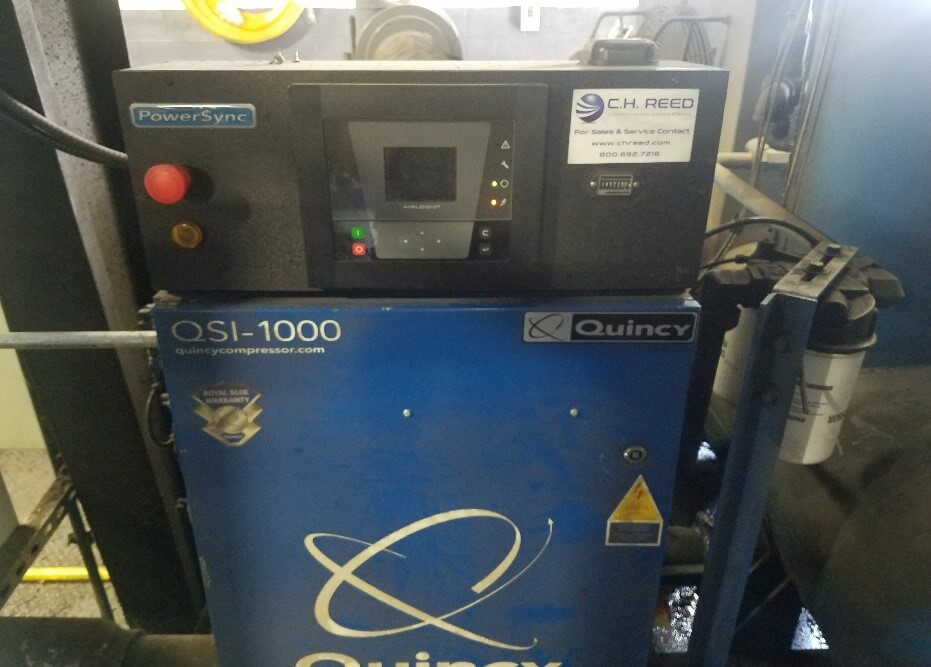
The Older Quincy QSI-1000 retrofitted to the Air Logic 2 controller.
Compressor A and Compressor B were fitted with Quincy Compressor’s CANBox. (The CANBox is a network interface that takes information exchanged on the network and converts it to digital input and output signals. For more information on the CANBox, click here.) The remote start/stop function of Compressor B’s Auto Sentry controller was tied into the CANBox to allow the network to bring the compressor on and off line as needed. The local setpoints of the controller were set much higher than network pressure to ensure that the compressor would start and load when it was commanded to. The local automatic shutdown timer had to be synced with the network shutdown timer to avoid network communication errors.
Compressor A, being a very old gauge machine, had no provision for remote controls of any kind. To make things even more fun, there was not an accurate wiring diagram to work from. All wiring in the local electrical box and the external starter cabinet had to be traced out. In the end, the CANBox was integrated into the compressor in such a way that it could control the machine from the network and local functionality was retained as well. Again, local pressure switch settings were adjusted up and the local shutdown timer had to be synced with the network shutdown timer.
With all modifications made and CANBoxes in place, the air compressors were tested both in, and out of network control. All compressors performed wonderfully under network control and maintained local control functionality as well.
Before the new system was installed, all five of the original air compressors had to run during full production to keep up with demand. That is 900 HP worth of air! After the new compressor was installed and the network was established, there are now only three air compressors running during full production, and one of them is using it’s lift valves to trim. That is roughly 662 HP with the new system, equaling a savings of 238 HP!
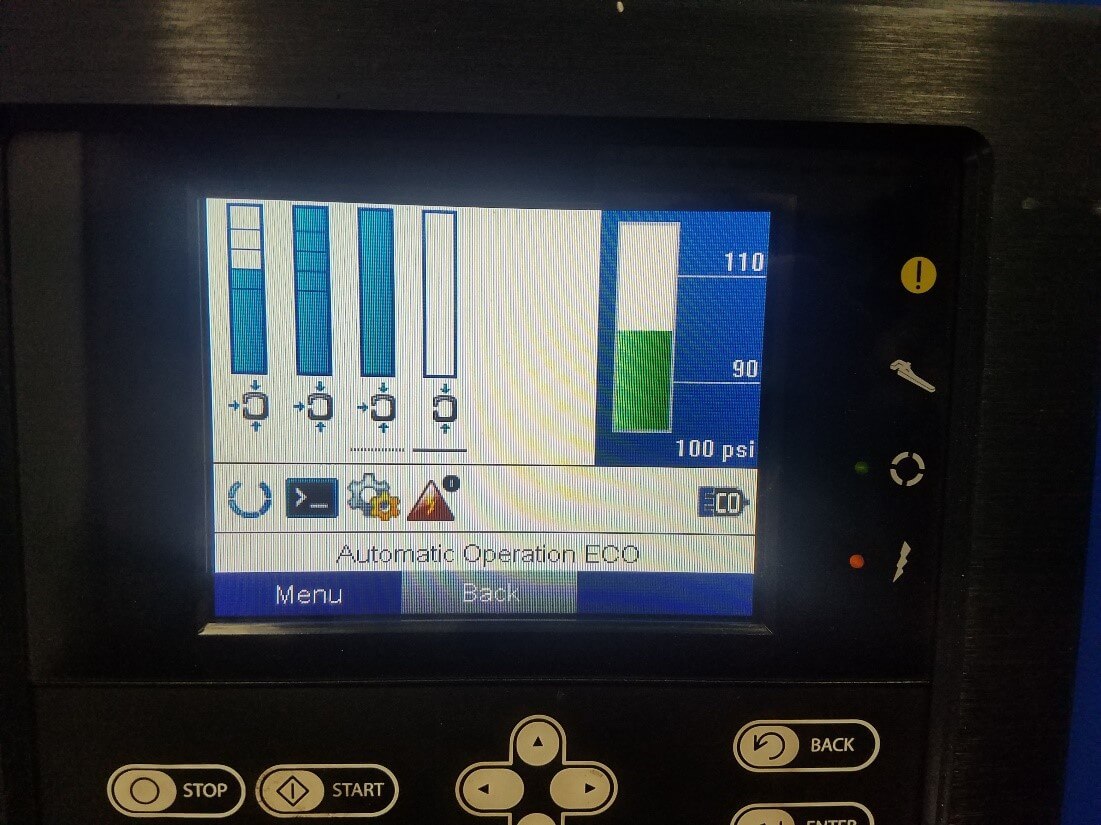
The network overview screen of the master, Quincy QSI-1500 compressor.
Compressed Air System Remote Monitoring
The new Quincy QSI-1500 came from the factory with ICONS installed. ICONS is Quincy’s remote monitoring system. It can alert the customer, and our service department, if a machine breaks down, is about to break down, or is due for maintenance. The premium version can monitor and trend performance data, and even make recommendations for system improvements (more on that later). With all that ICONS offers, our customer wanted it on all their air compressors. We made it happen for them.
The QSI-1500 came with ICONS standard. Easy enough. The Air Logic 2 controller we put on the QSI-1000 is made to work with ICONS. It’s a simple “plug and play” installation. Getting Compressors A and B on ICONS was a bit more involved.
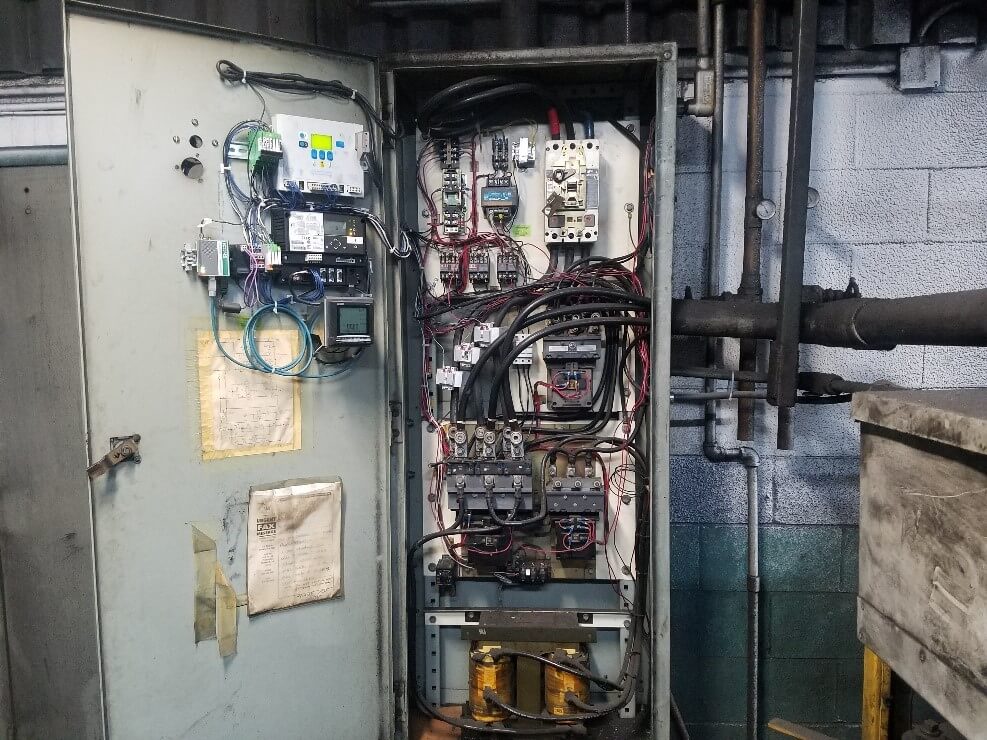
The external starter cabinet on Compressor A. Due to space restrictions, the CANBox, DINBox, ICONS module, and power meter had to be mounted on the door.
Fortunately, Quincy Compressor offers the DINBox. Much like the CANBox, the DINBox takes digital and analog inputs from the air compressor, and transmits them to the ICONS module where the information is uploaded to the ICONS website. The DINBox is default programmed to monitor digital inputs for running hours, loaded hours, and the Emergency Stop button. All inputs are programmable, so it can be customized for any application.
DINBoxes were installed on Compressor A and Compressor B. The Auto Sentry controller on Compressor B has a set of dry contacts for remote alarm monitoring. Those were utilized along with inputs for running hours and loaded hours. In this set up, ICONS will not transmit the exact fault if the compressor breaks down- ICONS doesn’t know what shut it down, it just knows the general fault contacts changed state. Thus, ICONS gives a “General Compressor Fault” message in the event of a break down.
Since Compressor A has no general fault contacts, all safeties were monitored individually. In addition to running hours and loaded hours, the fan motor and main motor overloads were tied into the DINBox, as well as the High Air Temp switch. Each point monitored has its own specific input. So, if the main motor overloads trip, ICONS will send a message “Overload Main Motor”. When this kind of information is sent via ICONS, it can take a lot of the guess work out of troubleshooting a machine that doesn’t have a controller telling you why it shut down. This can save valuable time getting an air compressor back up and running, saving you $$$.
Air Compressor Technologies & Performance Verification
Trend graphs from the Quincy ICONS website show the measured power of each air compressor over time. This data is trended and stored indefinitely and is accessible to the customer and the C.H. Reed Service Department.
Power meters were installed on all four of the air compressors. This gives the customer, and the C.H. Reed Service Department, real time data about the power consumption of each air compressor. This data can be checked periodically and analyzed to see if there are any situations that need addressed. For example, Compressor A is now strictly a back-up compressor. If the power trends were checked, and it was discovered Compressor A was running during peak production hours, we would contact the customer and set up an appointment to go and find out why that is happening. Similarly, if an air compressor was found to be consuming slightly more power over time (an upward trend), we would need to find out why. This may lead to catching and fixing a problem before it becomes catastrophic and causes unplanned down time, again saving the customer $$$.
Case Study Conclusion
In the end, this combination of air compressor technologies (networking, remote monitoring, and performance verification) has proven to be a very powerful ally in keeping this compressed air system running at peak efficiency. With the right technology, and a little ingenuity, any compressed air system can be brought to outstanding levels of performance, redundancy, and efficiency.
To learn more about air compressor controls and C.H. Reed’s advanced networking capabilities, contact us today!
Search
Categories
Get a consultation
Related Posts
The 3 Distinct Advantages of Hydraulic Powered Pumps
Recently, C. H. Reed helped a major printing operation install a new ink pumping system. The new system needed to transfer four colors of high viscosity, heat-set ink to their three presses, drawing the ink from multiple 5,000…
Simple Ways to Reduce Waste in Your Spray Finishing System
In today’s demanding manufacturing landscape, it can be convenient to adopt a “cut-costs-at-all-costs” mentality, justifying questionable means for the sake of leaner production, a lower bottom line and increased profitability. Regrettably, those efforts can interfere…
What You Need to Know About Air-Powered Pressure Washers
Pressure washers are great solutions for your average cleaning applications, but what tool do you turn to for your more challenging applications? There are many instances where it is simply impossible to use a traditional…